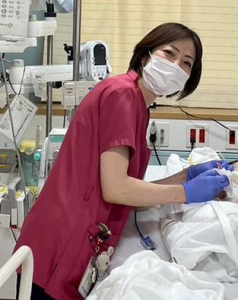9 Japan, Katsuko Sakamoto
Japan
Japan is in East Asia and consists of a chain of islands in the Pacific Ocean east of the Korean Peninsula and China. It has approximately 124 million inhabitants.
 I am Katsuko Sakamoto, working as a Certified Nurse in Intensive Care (CNS) in the PICU at Hyogo Children’s Hospital in Japan, where I was responsible for nursing practice in the PICU and education and consultation to the staff. Since April this year, I have been attending the Certified Nurse Specialist in Child Health Nursing course at the Kobe City University of Nursing Graduate School.
I am Katsuko Sakamoto, working as a Certified Nurse in Intensive Care (CNS) in the PICU at Hyogo Children’s Hospital in Japan, where I was responsible for nursing practice in the PICU and education and consultation to the staff. Since April this year, I have been attending the Certified Nurse Specialist in Child Health Nursing course at the Kobe City University of Nursing Graduate School.
The outbreak of COVID-19 led to severe restrictions on visits to inpatients at almost all hospitals in Japan. The same was true for hospitals specializing in children. Especially in the early stages of the epidemic, we had to prohibit all visits, which made it impossible for us to provide the patient- and family-centered care that we usually did. For the families of children in the PICU, especially those in critical condition, not being able to obtain information about their child’s condition, treatment and care, and most importantly, the environment in which the child was placed, caused much more anxiety and worry. We usually observe the family’s facial expressions, behaviors, and interactions with the child during visits and provide the necessary care. We feel the importance of non-verbal information such as facial expressions, mood, etc., as well as words. This was a dilemma and stressful situation for us nurses as well.
In this context, we incorporated remote visitation via ZOOM as a way to resolve the situation where families could not see their children due to visitation restrictions imposed by COVID-19. As a result, we were able to see smiles on the faces of the children and their families, but we realized that this was not enough support for the families. We were constantly thinking about what we could do to provide the best possible care for the child and family in a situation that none of us could predict, and yet still provide the best possible care for the child and family.
According to the results of a survey1) we conducted on family and nurses’ feelings about visitation restrictions and remote visitation during the COVID-19 epidemic, more than 90% of both groups viewed the visitation restrictions positively, probably due to their understanding of the risk of infecting a seriously ill child. However, family members felt anxious about not being able to see their children, and nurses felt that nursing care was inadequate. In addition, both family members and nurses felt that remote visitation was effective in providing visual information, but at the same time, a few said that the very short and limited visits made them feel even lonelier and more anxious. On the other hand, the results also showed that remote visitation could be even more useful, as it enabled the participants to meet with siblings and grandparents whom they normally would not be able to see.
There may be limits to what we can do in situations like this one, but it is really important for us not to give up when it is impossible. In fact, there have been several cases where the medical staff has discussed and granted special visits to families of children who needed to make tracheotomy choices or end-of-life choices. I usually believe that when critical treatment decisions need to be made, it is impossible to determine the best choice for the child without seeing him or her. In working with families who have had their visitation restrictions lifted this time, seeing their reactions to the child’s condition, their fluctuating feelings in decision-making, and the decision-making process has further convinced me of the importance of visitation in my perception of this.
We need to continue to think about how to support families during visits, how to visit, and the environment of the PICU for children and families so that we can continue to improve it after COVID-19 has been completed. Above all, our mission as nurses is to create the best possible environment for the children. First of all, we should all know that it is not normal for a child to not be able to see their family when they want to, even if they are in the hospital or in a critical condition.
In Japanese:
私は、日本の兵庫県立こども病院のPICUで集中ケア認定看護師(Certified Nurse in Intensive Care)として勤務している坂本佳津子です。PICUでの看護実践とスタッフへの教育、相談の役割を担っていました。今年の4月からは神戸市看護大学大学院で小児看護専門看護師(Certified Nurse Specialist in Child Health Nursing)コースに通っています。
COVID-19の爆発的な流行により、日本ではほとんど全ての病院で入院患者への厳しい面会制限(または禁止)が行われました。それは、子どもの専門病院でも同様でした。特に流行の初期には、一切の面会を禁止しなければならず、私たちが通常行っていた、患者と家族中心の看護が十分に行えない状態となりました。特にPICUという重症な状態の子どもの家族にとって、子どもの状態はもちろん、治療やケアの様子や子どもの置かれている環境のほとんどの情報を得られないことは、より多くの不安や心配を与えることになったと思います。私たちは通常、面会時の家族の表情や言動、子どもとのやりとりを観察し、必要なケアを行っています。そして、言葉だけではなく、表情や雰囲気など非言語的に家族が表す情報の重要性を日々感じており、対面での面会制限によりそれらの情報が得られないことは、私たち看護師にとっても、大切にしている「相手の様子を慮り、寄り添うというケア」ができないことによるジレンマやストレスを与えるものでした。
その中で私たちは、COVID-19 による面会制限で家族が子どもに会えない状況を解決する方法として、ZOOMでの遠隔面会を取り入れました。結果として、私たちは子どもたちや家族の笑顔を見ることができましたが、家族への支援としては不十分であることを実感していました。誰もが予測できない状況の中で、それでも子どもと家族にとって最善のケアを提供するために、何ができるかを常に考え続けていました。
私たちが、COVIS-19流行時の面会制限と遠隔面会に対する家族と看護師の思いについて実施したアンケート1)の結果では、両者とも、面会制限に対しては、重症な子どもへの感染のリスクの理解からか、90%以上が肯定的に捉えていました。しかし、家族は子どもと会えない不安を、看護師は看護ケアの不十分さを感じていました。また、遠隔面会については、家族も看護師も視覚的な情報が得られることによる効果を感じると同時に、ごく短時間の限られた面会では、余計に寂しさや不安が増したと言う少数意見もありました。一方で、通常会えないきょうだいや祖父母との面会が実現するなど、遠隔面会のさらなる有用性も感じられる結果でした。
今回のような事態において、私たちができることに限界はあるかもしれませんが、無理だと諦めないことは、私たちにとって本当に大切なことだと思います。実際に、気管切開の選択や終末期の選択が必要な子どもの家族に対して、医療スタッフが話し合い、特別に面会を認めたケースがいくつかあります。私は普段から、治療の重大な意思決定が必要な時、その子にとっての最善の選択を、その子の顔を見ずに判断することはできないと思っています。今回の面会制限を解除した家族との関わりの中で、子どもの状態に対する家族の反応や意思決定における気持ちの揺らぎ、決定のプロセスを見て、このことについての認識はさらに確信に近づき、面会の重要視を実感しました。
面会時の家族のサポートの仕方、面会方法、子どもと家族にとってのPICUの環境など、COVI-19が一段落した後も改善し続けられるよう、これからも考えていく必要があります。何よりも、子どもたちにとって最善の環境を作ることが私たち看護師の使命です。まずは、たとえ入院中であっても、重篤な状態であっても、子どもが家族に会いたいときに会えないという状況が、当たり前ではないことを、みんなが知るべきだと思います。
Additional Information About Nursing in Japan
The public healthcare system in Japan is known as the Social Health Insurance (SHI). It is funded through a mix of employer-based insurance and government programs. SHI applies to residents who are employed full-time with a company. Roughly 5 % is deducted from their salaries to pay for health coverage and employers must match this cost. Residents who do not qualify for SHI receive coverage through the National Health Insurance (NHI) plan. The Japanese healthcare system emphasizes preventative care and community health services. According to the Japanese Nursing Associations, Japan has approximately 1.5 million nurses, with approximately 11 nurses per 1000 population. Nursing Education is typically a three-year diploma or a four-year Bachelor of Nursing (BSN) degree, which prepares students to take the Japanese Nursing licensure Exam. Upon graduation and completion of the licensure exam, Nurses can work in hospitals, long-term care facilities, clinics, or community health centers to meet the growing demand for healthcare services in the aging Japanese society.
Media Attributions
- Katsuko Sakamoto 1-1
